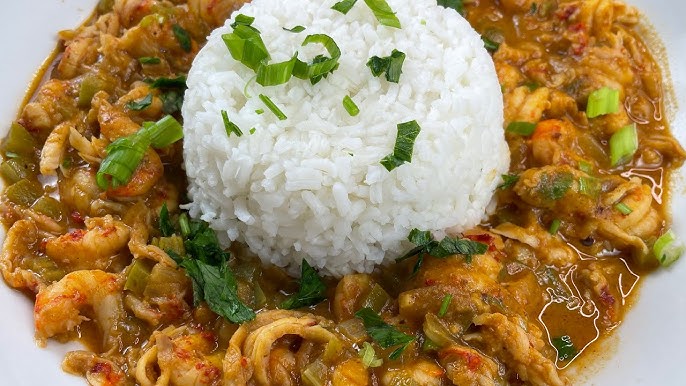Crawfish Etouffee Recipe: When it comes to Southern cuisine, few dishes capture the heart of Louisiana like crawfish étouffée. This rich, savory dish is a staple in both Cajun and Creole kitchens.
Étouffée, meaning “smothered” in French, combines crawfish, vegetables, and a buttery roux to create a meal that’s hearty, comforting, and packed with bold flavors.
Ready to dive into this classic recipe? Let’s break it down step by step.
What is Crawfish Étouffée?
Crawfish étouffée is a dish where crawfish tails are gently simmered in a rich, seasoned sauce thickened by a roux. The term “étouffée” refers to the method of slowly smothering ingredients to build deep, complex flavors. Originating in Louisiana, it blends the influences of Cajun (country-style) and Creole (city-style) cooking. While crawfish is traditional, other variations like shrimp and chicken étouffée are equally popular.
The flavor is a balance of savory and spicy, thanks to the combination of garlic, onions, bell peppers, and various Cajun spices. Its velvety texture comes from the careful preparation of the roux—a cooked mixture of butter and flour.
Ingredients Needed for Crawfish Étouffée
To prepare an authentic crawfish étouffée, you’ll need the following ingredients:
- Crawfish tails: Either fresh or frozen (pre-cleaned)
- Vegetables: Onion, bell peppers, and celery (collectively known as the “Holy Trinity”)
- Butter: For the roux and sautéing
- Flour: To create the roux
- Garlic: Adds depth to the sauce
- Spices: Cajun seasoning, cayenne pepper, thyme, bay leaf
- Stock: Seafood stock enhances the flavor (chicken stock works as a substitute)
- Cooked rice: For serving the étouffée
These ingredients come together to form a dish that’s both comforting and full of complex flavors.
Essential Tools for Preparation
Having the right tools on hand will make the cooking process smoother and more enjoyable:
- Large Pot or Dutch Oven: Ideal for cooking the étouffée evenly.
- Mixing Utensils: Wooden spoons or silicone spatulas help stir the roux and sauce without burning.
- Measuring Cups and Spoons: For precise ingredient measurements.
- Rice Cooker (optional): To simplify rice preparation.
These kitchen essentials ensure you have everything you need to master this dish like a pro.
Preparing the Crawfish
If you’re using fresh crawfish, you’ll need to peel and clean the tails before cooking. Here’s how to do it:
- Peel the crawfish: Remove the head and shell, keeping only the tail meat.
- Clean thoroughly: Rinse the tails to remove any residual mud or grit.
- Remove the vein: Similar to deveining shrimp, use a small knife to remove the vein from the tail.
For frozen crawfish, let them thaw completely in the refrigerator and gently pat them dry before cooking. Proper preparation ensures your étouffée has the perfect taste and texture.
How to Make the Perfect Roux
The roux is one of the most important components of crawfish étouffée. It’s what thickens the sauce and gives it that signature depth of flavor.
- What is a roux? A roux is made by cooking equal parts fat (butter) and flour together.
- Cooking process: Melt butter in your pot over medium heat. Gradually whisk in flour, stirring constantly to prevent burning.
- Consistency: For étouffée, you’ll want a golden-brown roux—darker than a blonde roux but not as deep as a chocolate-colored roux used for gumbo.
Achieving the perfect roux takes patience. Keep stirring and monitoring the color to prevent scorching. Once you’ve nailed the roux, you’re well on your way to creating a rich, flavorful étouffée base.
The Holy Trinity of Cajun Cooking
No Louisiana dish is complete without the “Holy Trinity” of vegetables—onion, bell pepper, and celery. These three ingredients form the flavor foundation for many Southern dishes.
- Chop the vegetables finely to ensure even cooking.
- Sauté them in the roux until softened and fragrant, usually about 5-7 minutes.
- Importance: The Holy Trinity adds sweetness, complexity, and depth to the dish.
By taking the time to properly cook these vegetables, you create a flavorful backbone that supports the entire dish.
Adding Seasonings and Spices
To give crawfish étouffée its bold, unmistakable flavor, the right seasonings and spices are essential. Cajun cuisine is all about balance—savory, spicy, and a hint of sweetness.
- Cajun seasoning: Use a pre-mixed blend or make your own with paprika, garlic powder, onion powder, and cayenne pepper.
- Cayenne pepper: Adds heat. Adjust the amount to your spice tolerance.
- Bay leaves and thyme: Provide an earthy, aromatic undertone.
- Garlic: Intensifies the flavor, especially when sautéed.
- Salt and black pepper: For seasoning throughout the cooking process.
Remember, it’s better to start with less spice and add more as you go. Taste frequently to ensure the flavors develop to your liking. If you prefer more heat, a pinch of cayenne can do wonders!
Incorporating Crawfish into the Dish
Once the roux and vegetables are ready, it’s time to add the star of the dish—crawfish! Timing is crucial to ensure that the crawfish tails remain tender and juicy.
- Add the crawfish tails: Stir them into the simmering mixture gently.
- Coat with the sauce: Make sure each piece is coated with the roux and spices.
- Simmer: Allow the crawfish to simmer for about 10-15 minutes. Overcooking can make the crawfish rubbery, so keep a close eye on the timing.
Adding the crawfish near the end of the cooking process preserves their delicate texture and ensures that they soak up the flavorful sauce.
Simmering the Étouffée
Simmering is where all the magic happens. This step allows the flavors to blend and the sauce to thicken to the perfect consistency.
- Cover and simmer: Reduce the heat to low and cover the pot. Let it simmer for 20-30 minutes.
- Check the texture: The sauce should be thick but still pourable. If it’s too thick, add a bit of stock.
- Stir occasionally: Prevent the sauce from sticking to the bottom by stirring every few minutes.
By the end of the simmering process, your kitchen will be filled with the irresistible aroma of rich, Cajun spices.
Serving Suggestions
Crawfish étouffée is traditionally served over a bed of fluffy white rice, which helps balance the dish’s rich flavors.
- Spoon the étouffée over rice: A generous serving of rice helps soak up the delicious sauce.
- Garnish: Sprinkle chopped green onions and fresh parsley on top for color and a burst of freshness.
- Pair with sides: Cornbread, hush puppies, or a simple salad complement the étouffée perfectly.
This hearty dish is best enjoyed warm, with friends and family gathered around the table.
Tips for Perfect Crawfish Étouffée
Want to take your crawfish étouffée to the next level? Here are some insider tips:
- Use seafood stock: Instead of water, use seafood or chicken stock for a richer flavor.
- Don’t rush the roux: Patience is key when making the roux—it sets the foundation for the entire dish.
- Fresh ingredients: Whenever possible, use fresh crawfish and vegetables.
- Add a splash of lemon juice: This can enhance the flavors and cut through the richness.
By following these tips, you’ll impress even the most discerning Cajun food enthusiasts.
Common Variations of Étouffée
While crawfish étouffée is a classic, there are several variations that allow you to customize the dish based on your preferences:
- Shrimp Étouffée: Substitute crawfish with shrimp. This is another popular version in Louisiana.
- Chicken Étouffée: Use diced chicken breast or thighs for a heartier alternative.
- Vegetarian Étouffée: Replace the crawfish with mushrooms, tofu, or other plant-based proteins, and use vegetable stock.
These variations keep the dish exciting and adaptable for different tastes and dietary needs.
FAQs about Crawfish Etouffee Recipe
1. What is crawfish etouffee?
Crawfish etouffee is a classic Cajun and Creole dish from Louisiana, featuring crawfish smothered in a rich, spicy sauce made with a roux of butter and flour, vegetables like onions, bell peppers, and celery, and typically served over rice. It’s known for its deep flavors and hearty texture.
2. What kind of crawfish should I use for etouffee?
For authentic crawfish etouffee, fresh crawfish is preferred. However, if fresh crawfish is not available, you can use frozen peeled crawfish tails. Ensure they are thawed and well-drained to avoid watering down the dish.
3. Can I make crawfish etouffee without a roux?
While a roux is traditional for thickening and flavoring etouffee, you can make a lighter version without it. Use cornstarch dissolved in a little water to thicken the sauce instead, although this will alter the traditional flavor and texture slightly.
4. What can I serve with crawfish etouffee?
Crawfish etouffee is typically served over white rice, but you can also serve it with other side dishes such as cornbread, a fresh green salad, or steamed vegetables to balance out the richness of the dish.
5. How long can I store leftover crawfish etouffee?
Leftover crawfish etouffee can be stored in an airtight container in the refrigerator for up to three days. Reheat gently on the stove or in the microwave, adding a little water or broth if the sauce has thickened too much.
6. Is crawfish etouffee spicy?
The spiciness of crawfish etouffee can vary depending on the recipe. It typically has a bit of a kick from ingredients like cayenne pepper or hot sauce, but you can adjust these to suit your taste preference.
7. Can I substitute shrimp for crawfish in etouffee?
Yes, shrimp can be substituted for crawfish in an etouffee recipe. The cooking time may need to be adjusted as shrimp cook faster than crawfish. This substitution is handy when crawfish is not available or for those who prefer the taste of shrimp.
Conclusion
Congratulations—you’ve mastered the art of making crawfish étouffée! From the perfect roux to the bold Cajun spices, this dish is a true celebration of Louisiana’s rich culinary heritage. Whether you’re serving it for a special occasion or a cozy family dinner, crawfish étouffée is sure to impress.
So gather your ingredients, take your time with the roux, and enjoy the mouthwatering flavors of this iconic Southern dish. Bon appétit!



